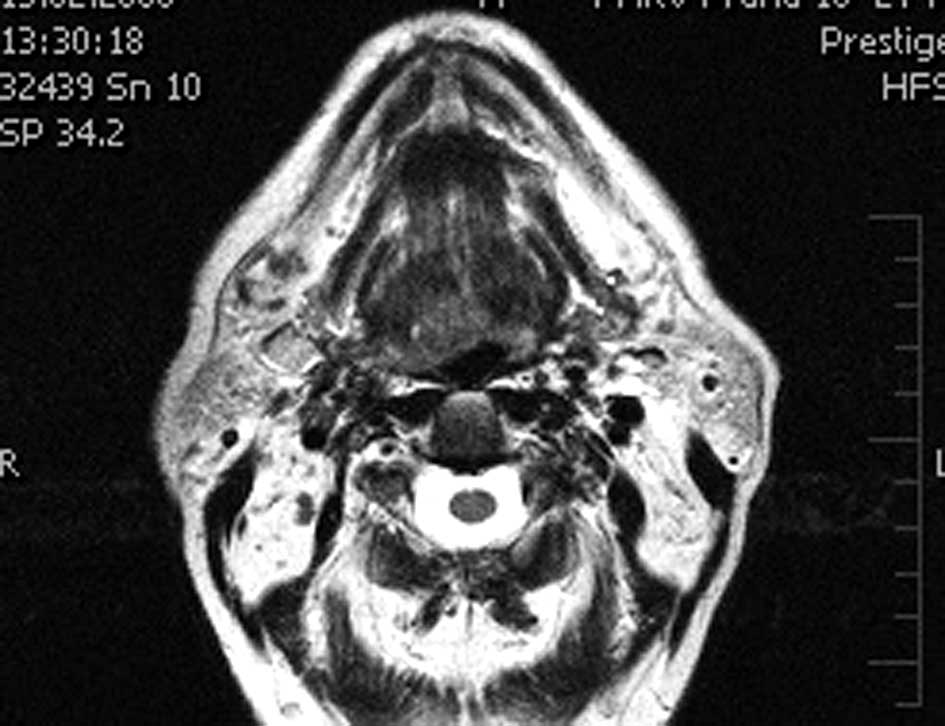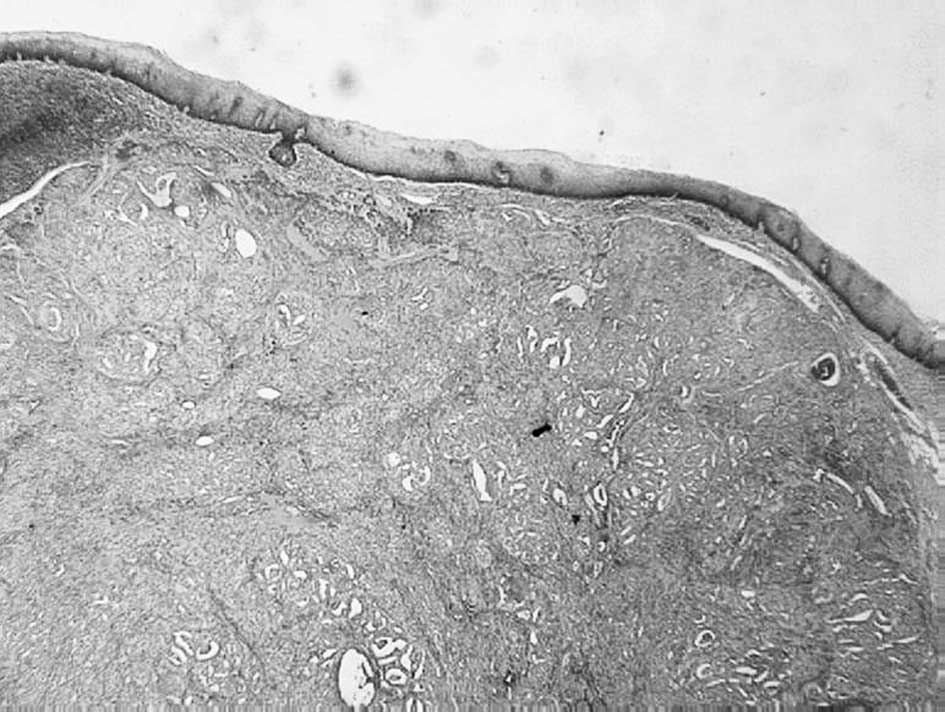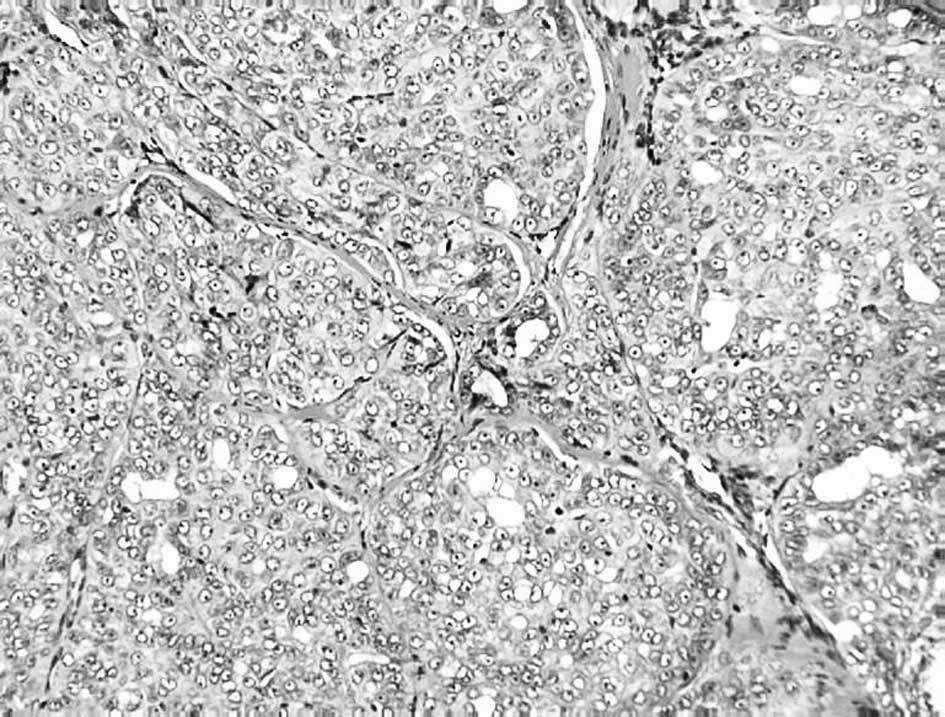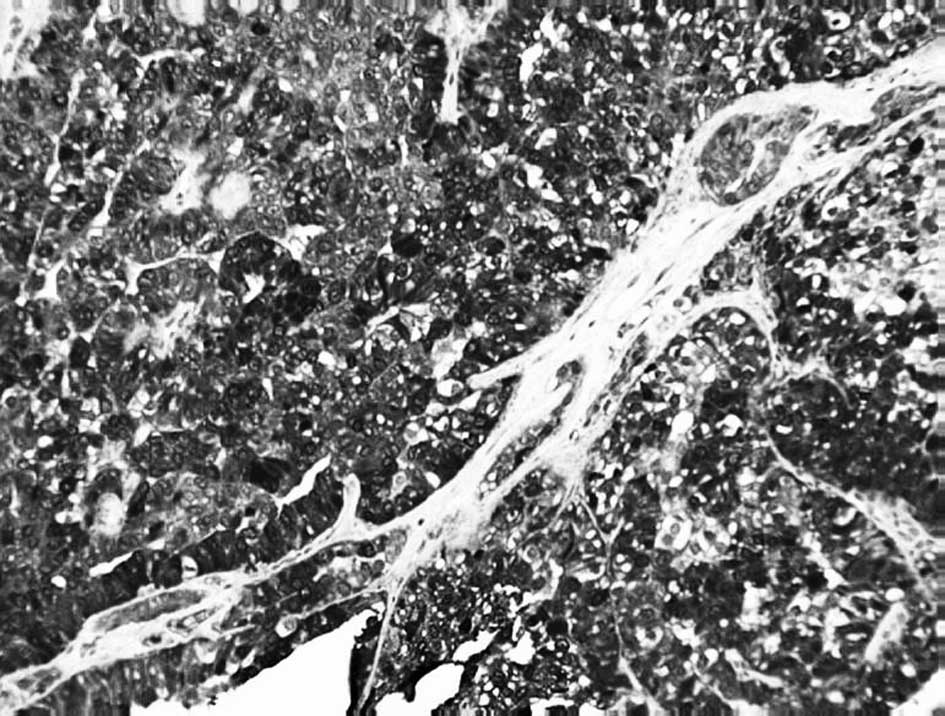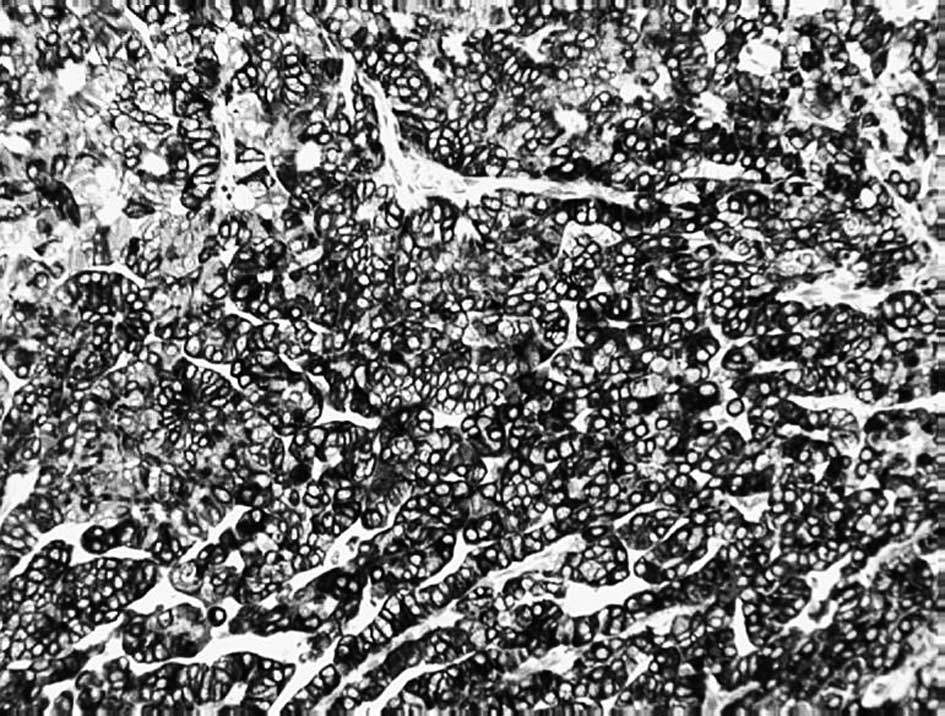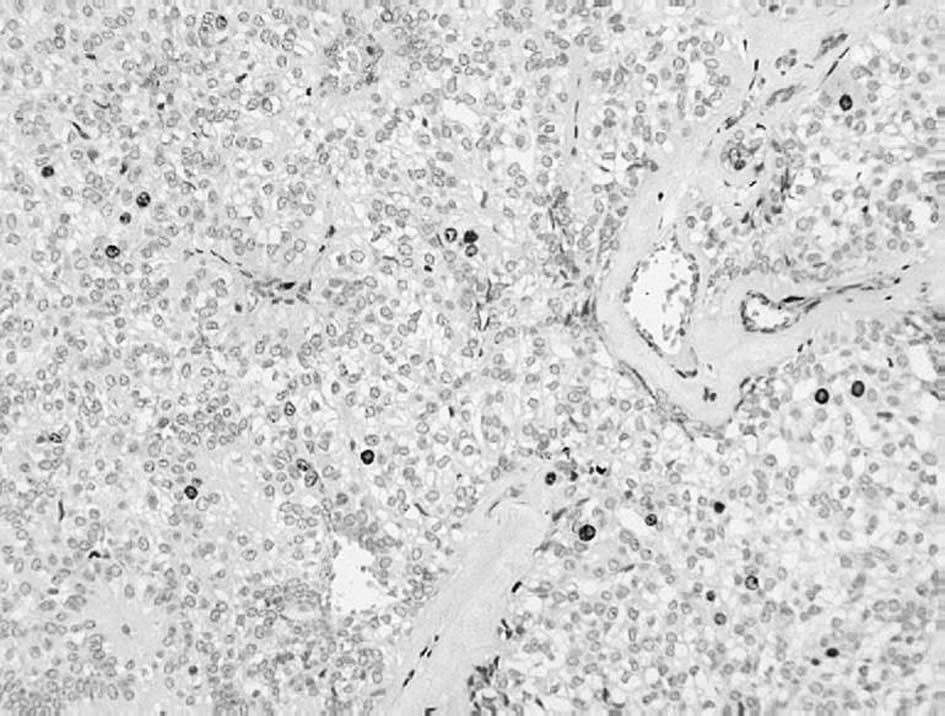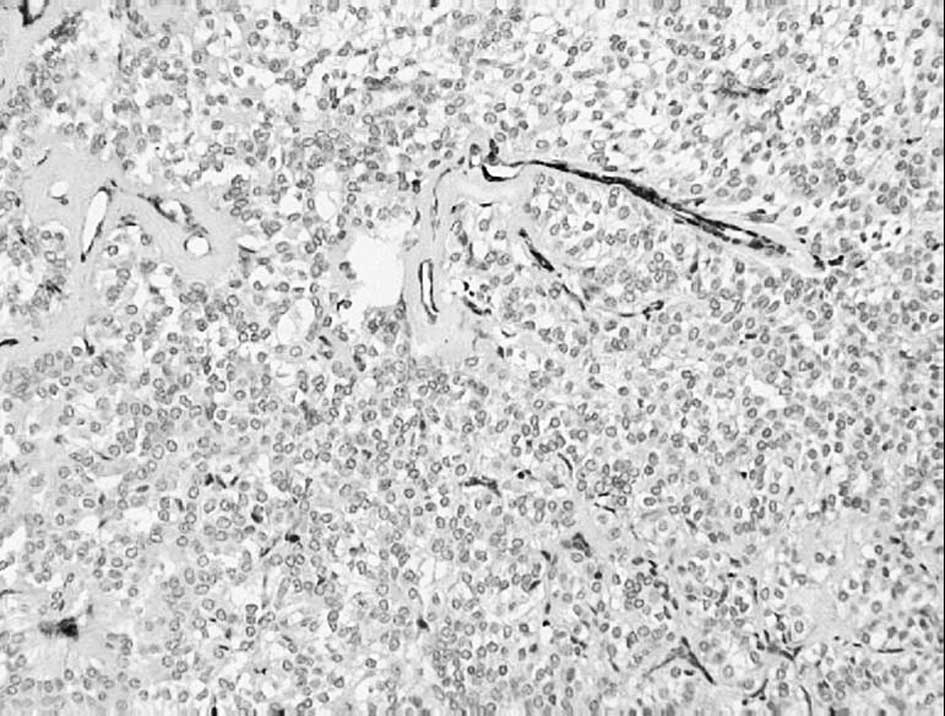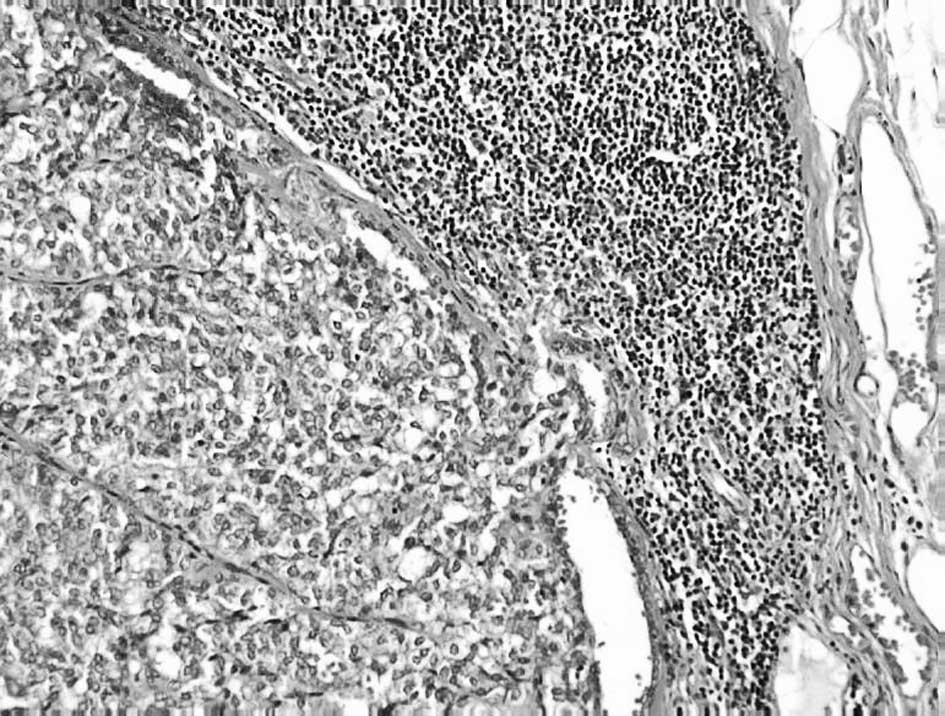Introduction
Cribriform adenocarcinoma of the small salivary
glands is defined as a low-grade, polymorphic adenocarcinoma based
on the World Health Organization histopathological classification
of carcinomas of the salivary glands (2005, Table I). The expression ‘low-grade,
polymorphic adenocarcinoma’, originally termed ‘terminal duct
carcinoma’, was introduced by Batsakis and Evans in 1983 (1,2). It
occurs primarily in females (70%), usually older than 60 years of
age, and more often in Africans and African-Americans. It is a
tumor that usually arises from the small salivary glands of the
palate and is microscopically unconfined (3). Tumor architecture is varied in that
cells have a regular round, elongated or ovoid nucleus with a
benign appearance. The nucleus is frequently vacualized, causing it
to resemble a papillary carcinoma of the thyroid gland,
particularly in tumors associated with the small salivary glands at
the base of tongue (4). Tumors
generally exhibit a low mitotic activity without an atypical
appearance. Immunohistochemically, the tumors are positive for
epithelial tumor markers, particularly cytokeratin and epithelial
membrane antigen, S-100 and α-SMA. The MIB 1 proliferative index is
low. The oncoprotein BCL-2 is expressed, but the expression of
tumor protein p53 is lacking (5).
The tumors are malignant, but not aggressive. Regional neck as well
as distant metastasis is rare and the mortality rate is low. For
these reasons, the accepted therapeutic method is radical surgical
removal without elective neck dissection or post-operative
actinotherapy (6).
 | Table IWorld Health Organisation
histopathological classification of carcinomas of the salivary
glands (2005). |
Table I
World Health Organisation
histopathological classification of carcinomas of the salivary
glands (2005).
| Acinic cell
carcinoma | 8550/3 |
| Mucoepidermoid
carcinoma | 8430/3 |
| Adenoid cystic
carcinoma | 8200/3 |
| Polymorphous
low-grade adenocarcinoma | 8525/3 |
|
Epithelial-myoepithelial carcinoma | 8562/3 |
| Clear cell carcinoma,
not otherwise specified | 8310/3 |
| Basal cell
adenocarcinoma | 8147/3 |
| Sebaceous
carcinoma | 8410/3 |
| Sebaceous
lymphadenocarcinoma | 8410/3 |
|
Cystadenocarcinoma | 8440/3 |
| Low-grade cribriform
cystadenocarcinoma |
| Mucinous
adenocarcinoma | 8480/3 |
| Oncocytic
carcinoma | 8290/3 |
| Salivary duct
carcinoma | 8500/3 |
| Adenocarcinoma, not
otherwise specified | 8140/3 |
| Myoepithelial
carcinoma | 8982/3 |
| Carcinoma ex
pleomorphic adenoma | 8941/3 |
| Carcinosarcoma | 8980/3 |
| Metastasizing
pleomorphic adenoma | 8940/1 |
| Squamous cell
carcinoma | 8070/3 |
| Small cell
carcinoma | 8041/3 |
| Large cell
carcinoma | 8012/3 |
| Lymphoepithelial
carcinoma | 8082/3 |
| Sialoblastoma | 8974/1 |
Cribriform adenocarcinoma of the small salivary
glands at the base of the tongue, as well as low-grade polymorphic
cancers, are unbounded tumors that are strongly S100-positive.
These tumors exhibit negative staining for the thyroid gland
markers TTF1 and TG. However, they differ from low-grade
polymorphic adenocarcinomas in that they metastasize to the lymph
nodes of the neck. While metastasis is already present at the time
of diagnosis, the prognosis remains positive.
Case Report
Patient
A 72-year-old female was examined at the ENT clinic
for a level II, right-side neck mass that had been present for 1
year, but without recent progression. Neck ultrasonography showed a
cystic formation of 4×3×1.5 cm. The patient underwent thyroid gland
surgery in 1991, in another clinic, and sonography showed residue
in the bed of the right lobe of the gland. The patient had also
undergone a childhood tonsillectomy for recurrent tonsillitis. The
cystic mass was extirpated; macroscopically it appeared cystic with
dark contents.
Methods
Initial histology suggested a well-differentiated
metastasis of a myoepithelial cancer of the salivary glands. Tissue
was sent for further histological examination to a laboratory
specializing in the histological examination of salivary glands.
Nuclear magnetic resonance was carried out, where an unconfined,
poorly differentiable infiltration was found at the base of the
right half of the tongue (Fig. 1).
An endoscopic examination was performed and multiple biopsies were
removed from the right side of the tongue base; however, the
biopsies were histologically negative. A second endoscopic biopsy
was performed, and again the histological findings were negative.
Given the circumstances, a right side neck dissection of cervical
lymph nodes, sparing cranial nerve XI, and a lateral pharyngotomy
with repeated preoperative biopsies, from the base of the tongue,
was performed. The results revealed an adenocarcinoma at the base
of the tongue. A resection of the tumor at the base of the tongue
was performed together with a temporary tracheostomy. The
tracheostomy was discontinued post-operatively and the patient was
scheduled for post-operative radiotherapy due to the neck
metastasis. Further histological investigation of the peroperative
biopsies together with the neck metastases confirmed the diagnosis
of rare cribriform adenocarcinoma of the small salivary glands at
the base of the tongue. The patient is currently 3 years
post-radiotherapy without any local or regional recurrence of the
disease.
Results
Histological findings
Findings from the histological examinations are
shown in Figs. 1–8. The cribriform arrangement of the tumor
is shown in Fig. 2. The tumor was
highly positive for the S100 protein (Fig. 3) and the epithelial marker
cytokeratin CK 7 (Fig. 4).
Proliferative activity of the tumor was low [proliferative marker
MIB 1 (Ki-67)] (Fig. 5). The tumor
stained negative for actin (Fig. 6)
and thyroid tumor markers TTF1 and TG were also negative. Fig. 7 shows the histology of the neck
lymph node metastases. Fig. 8 shows
the intact epithelial surface of the base of the tongue where the
unconfined tumor developed, rendering the imaging examinations a
challenge.
Discussion
Cribriform adenocarcinoma of small salivary glands
is a rare tumor. According to the current WHO classification
(2005), these tumors are included among low-grade polymorphic
carcinomas, despite a strong tendency to metastasize to the
cervical nodes, as shown in our case study and noted in the
literature (4). While low-grade
polymorphic carcinomas usually arise from small salivary glands of
the palate, cribriform adenocarcinomas often arise from the small
salivary glands at the base of tongue. This is highly significant
in cases where the patient presents with neck metastasis from a
tumor of unknown origin. If a diagnosis of metastasis from a
cribriform adenocarcinoma is established by histopathological
examination, it is reasonable and prudent to assume that the
primary tumor is located at the base of the tongue and focus
attention on this region. However, as noted in our case report,
obtaining a positive histological result from the base of the
tongue is challenging since the tumor grows unconfined under an
intact epithelial surface (Fig. 8).
Insufficiently deep excisions explain the negative histology.
Additionally, the unconfined infiltration of the tumor renders
imaging examinations challenging.
In conclusion, cribriform adenocarcinoma is
currently included in a group with low-grade, polymorphic
adenocarcinomas of the salivary glands. Cribriform adenocarcinoma
has numerous characteristics in common with typical low-grade,
polymorphic adenocarcinomas, including unlimited growth, low
mitotic activity (low proliferative index of MIB 1), positive
epithelial markers (particularly S-100 and cytokeratin), a
resemblance to papillary carcinoma of the thyroid gland (although
TTF1 and TG markers are negative), expression of the BCL-2
oncoprotein, without expression of tumor protein p53 and an equally
favorable prognosis. Cribriform adenocarcinomas differ, however, as
they metastasize to the cervical lymph nodes and exhibit frequent
primary localization in the small salivary glands at the base of
the tongue. This tendency is in contrast to low-grade, polymorphic
adenocarcinomas that are associated with the small salivary glands
of the palate and a negligible tendency towards neck lymph node
metastasis. In light of neck metastasis, neck dissection and
post-operative radiotherapy for cribriform adenocarcinoma are
imperative. The magnitude and implications of the differences
between the above-mentioned conditions may result in the removal of
this tumor from the group of low-grade polymorphic adenocarcinomas
and its reclassification as a separate entity with distinctive
biological attributes.
References
|
1
|
Batsakis JG, Pinkston GR, Luna M, et al:
Adenocarcinomas of the oral cavity: a clinicopathologic study of
terminal duct carcinomas. J Laryngol Otol. 97:825–835. 1983.
View Article : Google Scholar : PubMed/NCBI
|
|
2
|
Evans HL and Batsakis JG: Polymorphous
low-grade adenocarcinoma of minor salivary glands: a study of 14
cases of a distinctive neoplasm. Cancer. 53:935–942. 1984.
View Article : Google Scholar : PubMed/NCBI
|
|
3
|
Ellis GL and Auclair PL: Tumors of the
salivary glands. Atlas of Tumor Pathology. Ellis GL: AFIP;
Washington, DC: pp. 216–228. 1996
|
|
4
|
Michal M, Skálová A, Simpson RH, et al:
Cribriform adenocarcinoma of the tongue: a hitherto unrecognized
type of adenocarcinoma characteristically occurring in the tongue.
Histopathology. 35:495–501. 1999. View Article : Google Scholar : PubMed/NCBI
|
|
5
|
Perez-Ordonez B, Linkov I and Huvos AG:
Polymorphous low-grade adenocarcinome of minor salivary glands: a
study of 17 causes with emphasis on cell differentiation.
Histopathology. 32:521–529. 1998. View Article : Google Scholar : PubMed/NCBI
|
|
6
|
Wenig BM and Gnepp DR: Polymorphous
low-grade adenocarcinoma of minor salivary glands. Surgical
Pathology of the Salivary Glands. Ellis GL, Auclair PL and Gnepp
DR: Saunderes; Philadelphia: pp. 390–411. 1999
|















